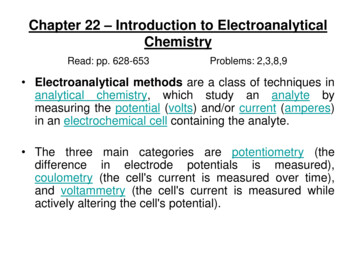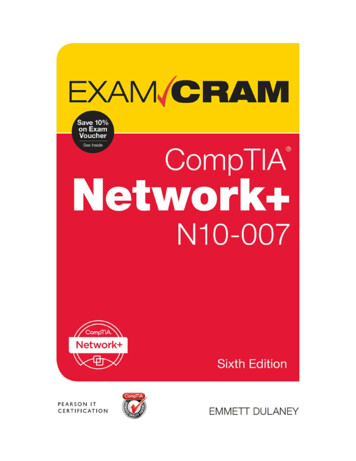
Transcription
Chapter 22 – Introduction to ElectroanalyticalChemistryRead: pp. 628-653Problems: 2,3,8,9 Electroanalytical methods are a class of techniques inanalytical chemistry, which study an analyte bymeasuring the potential (volts) and/or current (amperes)in an electrochemical cell containing the analyte. The three main categories are potentiometry (thedifference in electrode potentials is measured),coulometry (the cell's current is measured over time),and voltammetry (the cell's current is measured whileactively altering the cell's potential).
Electroanalytical MeasurementsElectrochemical (analytical measurements) are heterogeneous in nature.Electrolyte solutionOxElectrodee-Redi kCCurrent is also a directmeasure of reaction rate.Importantfactors: electrode material, electrolyte solution,surface cleanliness, and surface chemistry
Potentiometric MeasurementsPotentiometry passively measures the potential of a solution between twoelectrodes, affecting the solution very little in the process. The potential isthen related to the concentration of one or more analytes.VReference ElectrodeIndicator ElectrodeNo current flow!!OxOxOxOxEquilibrium potentialmeasurement!!0.0592Eind (vs.ref ) L log[ Ox]zExamples: pH measurement, ion selective electrodes, gas sensingelectrodes
Voltammetric MeasurementsVoltammetry applies a constant and/or varying potential at an electrode's surface andmeasures the resulting current with a three electrode system. This method can revealthe reduction potential of an analyte and its electrochemical reactivity. This method inpractical terms is nondestructive since only a very small amount of the analyte isconsumed at the two-dimensional surface of the working and counter electrodes.iWorking ElectrodeOx e- RedOxRedCounter Electrodei kC
Electrochemical Sensors for ClinicalAnalysisVarious electrochemical sensors can be used to measure importantanalytes in blood. They tend to be inexpensive, robust, sensitive andselective with the proper surface modification.Sensors 8 (2008) 2043-2081
Electrochemical CellsElectrochemical cells consist of two electrodes: an anode(the electrode at which the oxidation reaction occurs) and acathode (the electrode at which the reduction reactionoccurs).Cu(s) Zn 2 Cu 2 Zn(s)Cu(s) Cu 2 2e- (oxidation)Zn 2 2e- Zn(s) (reduction)There are two types of electrochemical cells: galvanic(ones that spontaneously produce electrical energy) andelectrolytic (ones that consume electrical energy).
Electrochemical CellsConduction1. Metals2. Solution (ionmigration)3. Electrode rxns(at interfaces)A potential difference between two electrodes representsa tendency for the reaction to occur!
Electrochemical PotentialsThe potential that develops in a cell is a measure of thetendency for a reaction to proceed toward equilibrium.E MeasuredE vs. RefEo [Ox]2.303RTlog nF[Red]Nernst Equationax [x]Standard reduction reactions: all relativeto the H2/H reaction, 298 K, unit activitiesfor all species, and pH 0.
Electrochemical PotentialsWe use concentrations in the Nernst equation, but reallyactivities are the proper term. The activity of a species canbe defined as the ability of a species to participate anequilibrium reaction involving itself.e.g.Fe 3 e- Fe 2 FeCl 2, etc.Depends on ionic strengthEcell Ecathode – Eanode Grxn - nFEcell Grxn -RTlnKeqKey equations
Reference ElectrodesAll cell potential measurements require two electrodes!1. AgCl(s) e- Ag(s) Cl-E Eo (0.059/n)log1/[Cl-]2. Hg2Cl2(s) 2e- 2Cl- 2Hg(l)E Eo (0.059/2)log1/[Cl-]2n number of electrons transferred per mole, 2.303 RT/F 0.059 V
Electrochemical CellsCu 2 H2(g) Cu(s) 2H Zn/ZnSO4 (aZn 2 1.00)//CuSO4 (aCu 2 1.00)/CuAnode (oxidation)Cathode (reduction)This shorthand is not always used in your textbook.
Electrochemical Cells and ReactionsElectrode (conductor) – Electrolyte (ionic trodes: Pt, Au, Pd, C, HgOx e-RedElectrolyte solutions (low ohmic resistance):ionic solutions (NaCl), molten salts, andionic polymers (Nafion).Electrode reaction kinetics are affected by the electrodesurface cleanliness, surface microstructure, and surfacechemistry.
Junction PotentialsPotentials developanytime there is chargeseparation!Ions move in thepresence of an electricfield.Differences in ion mobility giverise to junction potentials.Unequal distribution!1:1 electrolytes arenormally homogeneousin a solution and there isno charge separation.Ecell Ecathode – Eanode Ej
Equilbrium vs. Non-equilibriumElectrochemical MeasurementsPotentiometric (0 net current measurements, stablepotential that reflects activity of a reactant near the electrodesurface.)Voltammetric (a current flows in response to an appliedpotential.)When currents flow, net reactions take place. Since thereare two electrodes (a working and a counter electrode), anoxidation reaction occurs at the anode and a reductionreaction occurs at the cathode.Current (A coulomb/sec) is a direct measure of the rxn. rate!
Currents in Electrochemical CellsWhen currents are allowed to flow in electrochemical cells,this means that net reactions are taking place at eachelectrode. Equilibrium concentrations, as dictated by theNernst equation are not necessarily achieved on the timescale of the voltammetric measurement.E iR where R is the resistance in the cell. Some types ofresistance that can limit the current flow are charge-transferresistance, mass transport resistance and solution ohmicresistance.Ecell Ecathode – Eanode – iRi kCwhere C is the analyte concentration
Currents in Electrochemical CellsRemember all electrochemical reactions take place at theelectrode-solution interface!!Current limited by (i) chargetransfer resistance, (ii) masstransport resistance and ohmicsolution resistance.Modes of mass transport: (i) diffusion, (ii) convection and(iii) migration.i (current) Q/ t nFA(area, cm2) C/ t (flux, mol/s-cm2)
Chapter 22 – Introduction to Electroanalytical Chemistry Electroanalytical methods are a class of techniques in analytical chemistry, which study an analyte by measuring the potential (volts) and/or current (am










